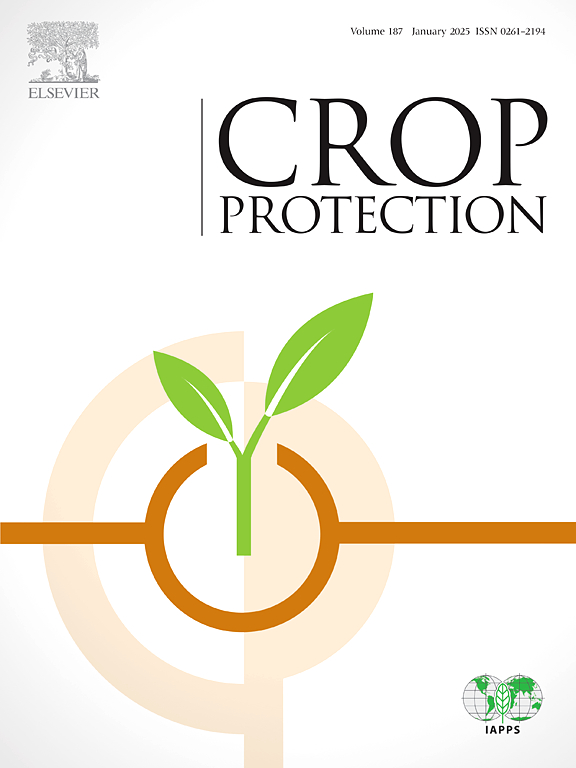Occurrence, molecular identification and phylogenetic analyses of viruses associated with garlic viral complex in Nepal
IF 2.5
2区 农林科学
Q1 AGRONOMY
引用次数: 0
Abstract
Garlic is a major spice crop in Nepal. A number of pathogens, including viruses, are known to cause economically important diseases in garlic. Garlic leaves showing leaf curl and mosaic symptoms and thirteen garlic accessions were collected from 12 districts. The accessions were planted under both the field and vector-free conditions. The leaf samples, collected directly from the fields and representative leaf samples from both field and vector-free growing conditions, were subjected to reverse transcription polymerase chain reaction (RT-PCR). Species of Potyvirus [(onion yellow dwarf virus (OYDV) and leek yellow stripe virus (LYSV)], Carlavirus [(shallot latent virus (SLV) and garlic common latent virus (GarCLV)], and Allexivirus [garlic virus A, D, H, and X (GarV-A, -D, -H, and –X)] were detected in mixed infections. Sequence and phylogenetic analyses showed that LYSV, OYDV, and GarCLV were closest to Indian isolates (including one LYSV isolate close to an Iranian isolate), SLV was close to Chinese isolates, and allexiviruses were close to Indian, Korean, and Chinese isolates. To our knowledge, this is the first report of SLV, GarV-A, GarV-D, GarV-H, and GarV-X in Nepal. The findings warrant plant quarantine measures and concerted research for their effective management.
尼泊尔大蒜病毒复合体相关病毒的发生、分子鉴定和系统发育分析
大蒜是尼泊尔主要的香料作物。许多病原体,包括病毒,已知会导致大蒜中的重要经济疾病。在12个地区采集到有卷叶和花叶症状的大蒜叶片和13个大蒜品种。在田间和无病媒条件下种植。采用逆转录聚合酶链反应(RT-PCR)对直接从田间采集的叶片样品和大田和无载体生长条件下具有代表性的叶片样品进行分析。在混合感染中检测到马铃薯病毒(洋葱黄矮病毒(OYDV)和韭菜黄条病毒(LYSV))、大蒜病毒(葱潜伏病毒(SLV)和大蒜普通潜伏病毒(GarCLV))和大蒜病毒(大蒜病毒A、D、H和X (GarV-A、-D、-H和-X))。序列和系统发育分析表明,LYSV、OYDV和GarCLV与印度分离株最接近(其中一个LYSV分离株与一个伊朗分离株接近),SLV与中国分离株最接近,而趋化病毒与印度、韩国和中国分离株最接近。据我们所知,这是尼泊尔首次报道SLV、GarV-A、GarV-D、GarV-H和GarV-X。研究结果表明,为有效管理植物检疫措施和协同研究是有必要的。
本文章由计算机程序翻译,如有差异,请以英文原文为准。
求助全文
约1分钟内获得全文
求助全文
来源期刊

Crop Protection
农林科学-农艺学
CiteScore
6.10
自引率
3.60%
发文量
200
审稿时长
29 days
期刊介绍:
The Editors of Crop Protection especially welcome papers describing an interdisciplinary approach showing how different control strategies can be integrated into practical pest management programs, covering high and low input agricultural systems worldwide. Crop Protection particularly emphasizes the practical aspects of control in the field and for protected crops, and includes work which may lead in the near future to more effective control. The journal does not duplicate the many existing excellent biological science journals, which deal mainly with the more fundamental aspects of plant pathology, applied zoology and weed science. Crop Protection covers all practical aspects of pest, disease and weed control, including the following topics:
-Abiotic damage-
Agronomic control methods-
Assessment of pest and disease damage-
Molecular methods for the detection and assessment of pests and diseases-
Biological control-
Biorational pesticides-
Control of animal pests of world crops-
Control of diseases of crop plants caused by microorganisms-
Control of weeds and integrated management-
Economic considerations-
Effects of plant growth regulators-
Environmental benefits of reduced pesticide use-
Environmental effects of pesticides-
Epidemiology of pests and diseases in relation to control-
GM Crops, and genetic engineering applications-
Importance and control of postharvest crop losses-
Integrated control-
Interrelationships and compatibility among different control strategies-
Invasive species as they relate to implications for crop protection-
Pesticide application methods-
Pest management-
Phytobiomes for pest and disease control-
Resistance management-
Sampling and monitoring schemes for diseases, nematodes, pests and weeds.
 求助内容:
求助内容: 应助结果提醒方式:
应助结果提醒方式:


